Best polyphonic synthesizers of 2019: The Top 6 new polysynths you can actually buy
Synths by Korg, Moog, Novation, ASM, Modal and Behringer
2019 has been a surprising and intense year for synthesizers and it looks like that’s going to be the trend going forward. Amongst the stunning polyphonic hardware synthesizers that arrived this year is it possible to pick out five that really dug into the juiciness of electronic sound generation? Of course it is! Here are the best synths with polyphony we saw in 2019.
Just to note to say that in order to qualify the synthesizer has to have become available for sale in the last 12 months, so no potential or imaginary synths. We’re still waiting for the release of synths like the UDO Super 6 and MotorSynth. And for “polyphony” I’m referring to the ability to play more than one note individually at a time regardless of whether that’s articulated through a single VCA/Filter (paraphonic) or has a VCA/Filter per voice (fully polyphonic). That opens the door to some synthesizers than many people would argue are not proper polysynths – that’s fine, life does have its challenges!
Moog Matriarch
This is where instruments, craftsmanship and art collide. The Matriarch is a beautiful instrument that’s full of character, adventure and promise. It has a vintage physicality and a palette that imposes itself on a room and a sound that envelopes you in a warm hug. It’s a semi-modular synthesizer made from modules taken from the classic Moog Modular synthesizers. It has a bold layout with those 4 oscillators front and centre, along with dual analog ladder filters, dual LFOs, dual VCAs and dual envelopes. There are 90 patch points along with useful control sculpting modules like Attenuators and Multiples. At the end of the chain is a stereo analog delay with up to 700ms of echo. The arpeggiator and 256-step sequencer gives it movement and melody all to itself.
It’s not complicated, this is a classy synthesizer capable of generating mono, duo or 4-voice polyphony with paraphonic articulation. It has an enjoyable and engaging elegance and a sound that will reward your explorations.
At just under £2000 it’s a big investment for 4 notes but somehow it feels completely worth it.
- Moog Matriarch webpage
- Buy this synthesizer (affiliate link)
Korg Minilogue XD
The original Minilogue was a great little synth and a bit of a groundbreaker in terms of cool, little polysynths. The Korg Prologue pushed the envelope that bit further last year with the introduction of the Multi-Engine custom oscillator and effects section. Dropping this remarkable feature into the Minilogue was a complete stroke of genius and gave Korg the opportunity to update their popular polysynth and now the Minilogue XD is one of the best polysynths out there.
It was released right at the start of the year making its debut at the NAMM show. It has 3 oscillators per voice, the third oscillator being the custom Multi-Engine that’s capable of loading third-party oscillators. It starts off with either noise or Variable Phase Modulation (similar to FM) giving it a good solid range of interesting digital sounds. Then you can add up to 16 more oscillators from a growing library from third-party developers. This also extends to the digital effects engine where you can load custom modulation, reverb and delay effects.
Outside of the custom oscillator, each voice has a filter, VCA, two envelopes and an LFO with an all-analogue signal chain. All the controls are laid out on the synthesizer that has a much better-balanced look than the original and looks great in black. The polyphonic step sequencer gives you 16 steps with 4 channels of motion control to create some fascinating movement and expression.
The Minilogue XD is a great little synth with bags of potential and behaves exactly how you’d expect a polysynth to work. Available with or without the 3-octave keyboard for £500 or £557 respectively.
- Korg Minilogue XD webpage
- Buy this synthesizer (affiliate link)
Novation Summit
Novation had already impressed us with the Peak polyphonic synthesizer. Summit gave them the opportunity to take what was great about Peak and develop it into a more fully-fledged 16-voice synthesizer that looks stunning and sounds amazing.
There is something about a full-sized keyboard-based synthesizer that makes it feel “proper”. Summit doubles up on the Oxford Oscillators to give 16-voices which can split into 2 complete 8-voice synthesizers if so desired. The oscillators can run as analogue waves, wavetable or FM and ar fed into dual analogue filters, distortion and VCAs. The extra space on the Summit gives room for more controls than the Peak with a section on FM, LFO and more detail on the filters.
The signal takes a true analogue path through the multi-mode filters and 3 stages of analogue distortion; pre and post-filter and post-VCA. This kind of architecture comes from the OSCar via the Bass Station II – Summit is a very fat and gorgeous-sounding synthesizer. At the end of the chain are some great sound digital effects that are also integrated with the modulation matrix and become an active and manipulable part of deeper patches.
Summit feels very competent, very ordered and deliberate. It’s less a synth of discovery and more one that will take you exactly where you want to go and at £1800 it’s a very different choice to the Matriarch.
- Novation Summit webpage
- Buy this synthesizer (affiliate link)
ASM Hydrasynth
Scraping into this years list by just about being available in the impressive-looking Hydrasynth. Impressive in two forms; one as a keyboard synthesizer with polyphonic aftertouch and a ribbon controller, and the other as a desktop unit that replaces the keyboard with 24 polyphonic and pressure-sensitive pads.
It’s a digital polyphonic wavetable synthesizer based on 3 oscillators for each of its 8 voices. Each oscillator can select from 219 single cycle waveforms. Oscillators 1 and 2 have an interesting Wavelist mode where you can select 8 waves and stack them in any order and then morph through them. From that point they are routed through the “Mutators” which allow you to bend and sculpt the waves in exciting ways. These include; FM, wave-stacking of up to 5 copies, Hard Sync, Pulse Width and Harmonic Sweep. Once you’ve finished messing about with the wave shaping it has two filters that can be set in series or parallel. One is a regular multi-mode filter with 11 different models, the second can sweep from low to band to high like a SEM filter.
For modulation there are 5 LFOs, 5 six-stage envelopes and a possibly endless modulation matrix with 32 user-definable routings. There are these useful patch Macros that let you attach multiple parameters to a single knob for some seriously deep performance possibilities.
The Hydrasynth is a huge engine of sonic possibility. For a digital synth they put a lot out on the front panel and I really like the visual flow of the button method of selecting which part of the synth you’re dealing with. The choice of keyboard or pads gives a different flavour to both offerings and the overall look is pretty tasty. Desktop version is £739 whereas the keyboard is £1152.
- Hydrasynth website.
- Buy the keyboard version. (affiliate link)
- Buy the desktop version. (affiliate link)
Modal Argon8
For my final choice I’m going to stick my neck out a bit and go for the Model Argon8. It’s only becoming available in December but it’s already impressed at shows over the last couple of months and if Modal’s pedigree is anything to go by this should be stunning. They released the Skulpt last year which had a lot of great ideas but felt constrained by the form factor. Argon8 addresses that by offering a proper synthesizer experience in form, function and, most importantly, sound.
Argon8 is an 8-voice polyphonic wavetable digital synthesizer with 120 wavetables split into 24 banks or 5 morphable sets. Each voice can run 4 oscillators loaded up with morphing wavetables being modified by Phase Modulation, Ring Modulation, Amplitude Modulation, Hard Sync and Windowed Sync. It’s like the oscillators are alive with movement and constantly evolving. The 2-pole filter can morph deliciously from low to band to highpass mode. There are three envelopes and two syncable LFOs and a large modulation matrix taking 11 sources to 52 destinations that all be played with a joystick controller. At the end of the chain is an independent stereo effects engine with waveshaping distortion, modulation, delay and reverb.
The sequencer can handle up to 512 notes with 4 channels of recordable modulation and animation for some wonderfully evolving sounds.
Argon8 looks the part and has an enormously rewarding sound engine in neat and compact form. The price of £579 is surprising and aggressive for a polysynth of this nature and deserves a place in my top 5.
Bonus: Behringer Poly D
Not sure that this was going to make it to release by the end of the year but Thomann has started taking preorders and they anticipate stock towards the end of December. In which case it can just about scrape itself into this list. The Behringer Poly D is a remarkable instrument. It’s everything that the Model D should have been. With the Model D Behringer captured the sound of the Minimoog but they didn’t capture the essence of the instrument. It was fiddly and squashed and although being compatible with a Eurorack case was some kind of feature it didn’t make it very exciting as a physical instrument. The Poly D changes all that.
The Poly D looks like a proper synthesizer and nicely reflects the original Minimoog that they’ve been trying so hard to capture. It has the wood, it has a 37 note keyboard with velocity and aftertouch, it has a pitch bend and modulation wheel and all the knobs are at the right size for fingering and fiddling. And for a modern twist the synth front panel hinges up to three different angles. But perhaps, more importantly, they’ve added a fourth oscillator and created two new playability modes.
Alongside the fat 4-oscillator mono mode is a duophonic Unison mode with 2-oscillators per voice or a Poly mode with a single oscillator each for 4-voice polyphony. The articulation is paraphonic meaning that they all go through the same filter and VCA which can make it odd when doing things like adding notes to a chord. Of course, it can be argued that it’s not really polyphonic but that’s no different from the Matriarch and I’m sticking with my view that polyphony is about the notes, not the articulation. They’ve also added a Distortion from the Boss DS-1 pedal, a Chorus based on the Juno 60 and a polyphonic sequencer and arpeggiator.
For £599 this is a fantastic looking synthesizer with vintage tones and quirkiness that puts Behringer’s synth game onto another level. Hopefully, just in time for Christmas.
4 responses to “Best polyphonic synthesizers of 2019: The Top 6 new polysynths you can actually buy”




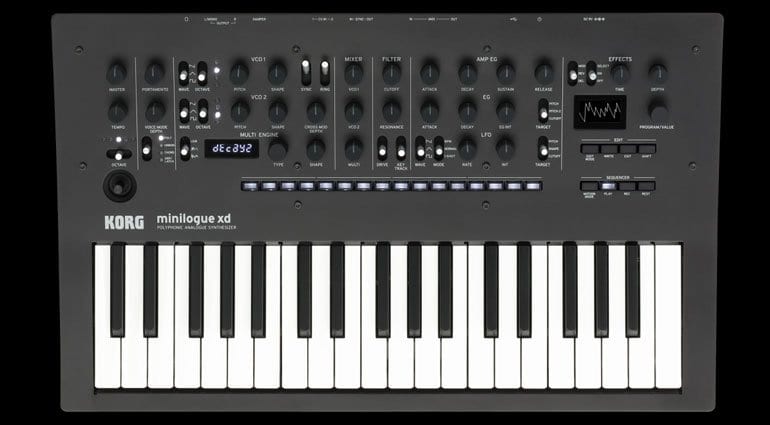

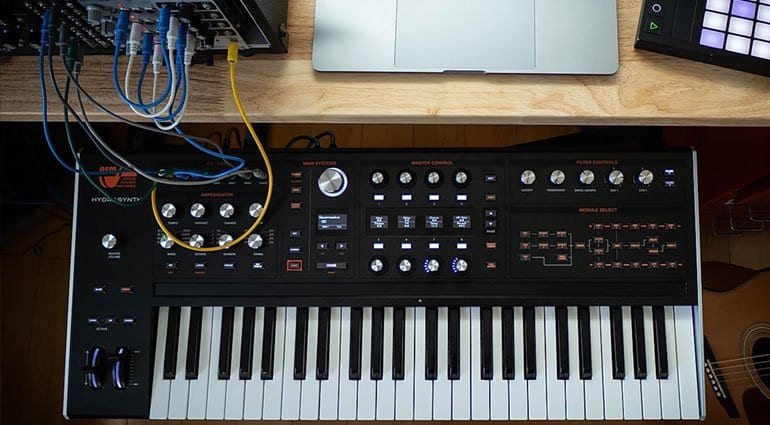
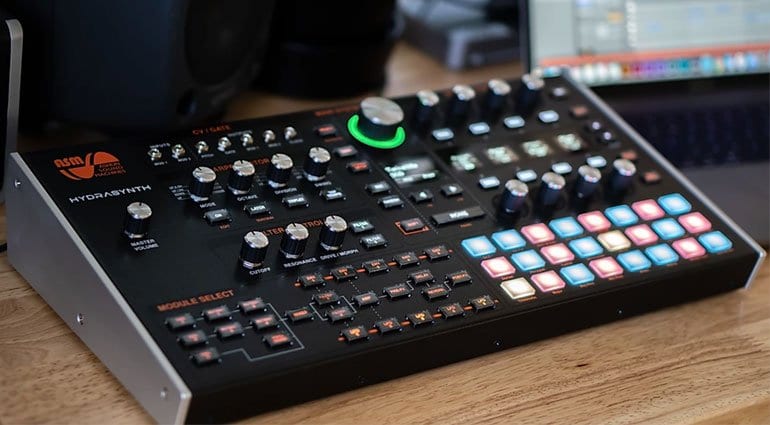


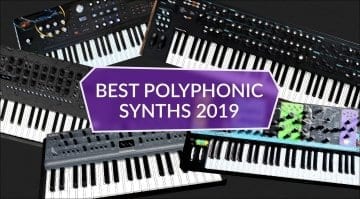


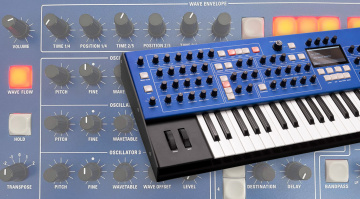
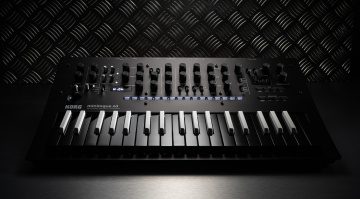


Does the preorder of the Expressive E Osmose with the EaganMatrix not count ^^?
Korg Minilogue XD please… its a toy
May we hear an example of the kind of elevated, no-nonsense results you’ve achieved using a proper, serious instrument?
I love the review. Been using a Razor Huntsman Gaming keyboard lately. It’s great but ain’t cheap. I like that your options aren’t super pricey. Glad I found this review.